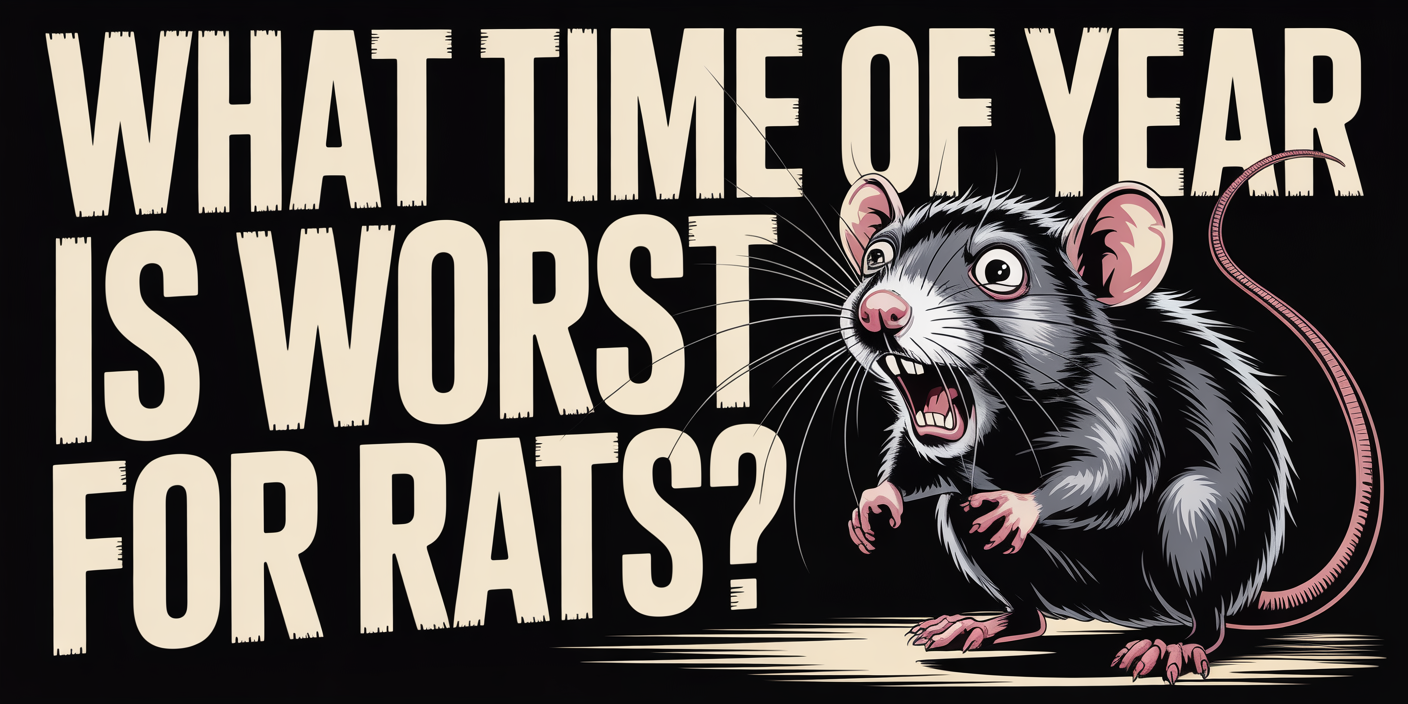“On the Treasure Coast, rat activity peaks from late October through February when cooler weather drives them indoors. Stay alert year-round, though—our warm climate lets rodents stay busy even outside that prime season.”
Rats and mice don’t take vacations—and in the Treasure Coast, they barely slow down. Thanks to Florida’s warm, humid climate, rat and mouse activity stretches far beyond what most regions see, keeping local pest control teams on their toes all year long. While many homeowners believe rodents only crash the party during winter, the reality is that Treasure Coast properties can face invasions any month of the calendar. Still, there’s a stretch when infestations spike and you’ll need fast control services from AAAC Wildlife Removal to get rid of rats before they settle in.
Understanding when these critters shift into high gear can help you safeguard your home before they move into your attic, garage, or crawlspace. Knowing the seasonal pattern means you can act early, shore up defenses, and skip the stress and damage that comes with a full-blown infestation. Let’s dive into the timing of rodent behavior on the Treasure Coast—and why it matters for keeping both mouse and rat intruders at bay.
Learn more: What do rats hate the most?
Peak Rat Season in Florida: When Activity Spikes
While rats in the Treasure Coast can be a nuisance all year long, their activity typically spikes from October through February. As temperatures drop—even slightly—rats begin looking for warm, secure places to shelter and raise their young. Unfortunately, homes and businesses offer the perfect setup: food, water, and a cozy attic or wall void to hide in.
During these cooler months, homeowners are more likely to hear scratching or scurrying sounds at night, especially in ceilings, basements, or behind appliances. You might also notice gnawed insulation, chewed wires, or rat droppings near food sources. Because Florida winters are mild, rats don’t go dormant—they just move indoors earlier and stay longer, making this season the most intense for infestations.
Why Treasure Coast Weather Fuels Year-Round Rat Trouble
Unlike northern states with deep freezes that slow rodent activity, the Treasure Coast’s subtropical climate gives rats a nearly endless runway to thrive. They don’t hibernate or slow down much here—instead, they adjust their behavior based on what the weather gives them. If it’s hot, they find shade. If it’s raining, they look for dry shelter. And unfortunately, that shelter is often your home.
Summer brings heavy rainfall and storm activity, which floods rat burrows and pushes them to higher, drier ground—like your attic or walls. Spring and early summer also trigger rapid vegetation growth, which creates more cover for rats to travel undetected through yards and neighborhoods. That’s why even outside of “peak season,” the Treasure Coast remains a prime environment for ongoing rat issues if homes aren’t properly sealed and monitored.
Rat Behavior by Season: What to Watch For
Fall & Winter: Indoor Invasion Mode
As temperatures start to dip and cooler weather returns, rats—and the occasional mouse—head indoors for steady warmth and food. They slip through tiny gaps into attics, crawlspaces, and garages, turning quiet corners into bustling nests during this busy rodent season. Holiday leftovers and overflowing trash give them all the fuel they need, making fast rodent control essential before numbers explode.
Spring: Nesting and Chewing Season
In spring, rodents remain active and often ramp up activity while scouting fresh nesting spots and raising litters. You’ll notice extra gnaw marks on insulation, plastic, and framing as rats and mice stay active throughout the year in Florida’s mild climate. Daytime scurrying increases once pups start exploring, so early rodent control steps pay off.
Summer: Seeking Shelter from Heat and Rain
Summer’s pounding rain and sweltering heat drive rodents to cooler, drier hideouts inside homes and sheds. Outdoor signs spike near HVAC units, garbage cans, and foundation corners, marking another busy stretch in certain seasons that follow heavy storms. Keeping vegetation trimmed and entry points sealed helps stop rats and mice before the next rodent season surge.
What Makes the Rat Problem Worse in Certain Months?
Seasonal changes don’t just influence rat movement—they also affect what’s available to them. During the holidays and cooler months, food waste tends to pile up, from pet food left outside to trash bins overflowing with leftovers. These easy meals can lure rats in and encourage them to stick around once they’ve found a warm spot to nest.
Post-storm damage is another key factor. Cracked siding, loose roof tiles, or open vents—common after Florida’s storm season—create easy access points for rats to slip through. In older homes, these gaps often go unnoticed until signs of infestation appear. Add in thick yard vegetation or clutter near the foundation, and you’ve got a setup that practically invites rats to move in.
How to Prepare Your Home Before Time of Peak Rat Season
Seal Up Entry Points
Inspect your home in early fall for cracks, holes, or open vents where mouse could squeeze through. Focus on the roofline, attic vents, crawlspaces, and foundation. Use steel wool, caulk, or hardware cloth to block any gap larger than a quarter-inch. These simple fixes can make a huge difference before mouse try to move in.
Trim Vegetation and Clear Yard Clutter
Overgrown landscaping gives rats cover and easy access to your roof or siding. Trim back bushes, tree limbs, and vines at least three feet from the house. Remove piles of wood, leaf debris, or storage containers where mouse could hide. A clean yard makes your home far less inviting.
Secure Food and Trash Storage
Pet food, birdseed, and even grill grease can attract mouse fast. Store all food in sealed, chew-proof containers—especially in garages or sheds. Make sure outdoor trash bins have tight lids and aren’t stored right next to the house. The less accessible your food waste, the less reason mouse have to hang around.
Schedule a Proactive Inspection
If you’re not sure where rats could sneak in, or you’ve had issues in the past, book a seasonal inspection with AAAC Wildlife Removal. Our team knows how rats behave specifically in the Treasure Coast and can identify high-risk zones you may miss. Catching it early means you avoid damage, stress, and the smell of an infestation.
Signs You May Already Have a Rat Problem
Scratching or Scurrying Noises
One of the earliest signs of a rat infestation is the sound of movement, especially at night. You might hear scratching in the walls, ceiling, or attic as rats move around or build nests. These sounds usually get louder as the infestation grows. If it sounds like something’s racing above your head, it probably is.
Droppings and Urine Trails
Rat droppings are small, dark, and capsule-shaped—often found near baseboards, pantries, or behind appliances. You may also notice greasy smudge marks or a musky smell caused by their urine trails. These signs indicate active travel paths and nesting areas inside your home. The stronger the odor, the worse the infestation is likely to be.
Chewed Materials and Wiring
Rats constantly gnaw to keep their teeth sharp, and that leads to real damage fast. Look for shredded insulation, bite marks on cardboard boxes, or exposed electrical wiring. Chewed wires are especially dangerous since they can spark fires, making this one of the most serious risks of a hidden infestation.
Unusual Pet Behavior
Dogs and cats often sense rodent activity before you do. If your pet starts staring at the wall, barking at air vents, or pacing near the attic door, it could be a sign something’s living where it shouldn’t. Don’t ignore these behaviors—they might be the clue that confirms a hidden rat presence.
Professional Rat Control in Treasure Coast, FL
When DIY methods fall short or the infestation grows too large to handle, it’s time to call in the pros. AAAC Wildlife Removal of Treasure Coast offers humane, effective rat control tailored to the unique conditions of Florida’s coastal communities. We don’t just get rid of rats—we stop them from coming back.
Our team starts with a detailed inspection to locate entry points, nests, and feeding areas. Then, we develop a custom removal and exclusion plan that includes sealing up your home, setting safe traps, and providing cleanup services. We also offer long-term prevention tips to keep your home rat-free year-round. When it comes to rats in Treasure Coast, we know exactly how to handle them.
Conclusion: Don’t Wait for Peak Season to Act
The worst time of year for rats in the Treasure Coast usually stretches from fall through winter, yet mouse activity never truly pauses, so the smartest way to prevent rats is to treat every month as part of rodent infestation season. Florida’s warmth lets rodents breed rapidly, and the periods when mice most active often overlap with peak rat surges, turning a small problem into an expensive headache fast. Staying proactive all year protects your home and sanity.
If you want real peace of mind, call AAAC Wildlife Removal of Treasure Coast for professional pest control. Our comprehensive pest control services include detailed inspections, proven removal methods, and long-term exclusion strategies that stop rodents before they start multiplying. Act now, and keep your home safe, clean, and rodent-free in every season.




